Global Food Security under COVID-19: Comparison and Enlightenment of Policy Responses in Different Countries
Abstract
:1. Introduction
2. Literature Review, Materials and Methods
2.1. Literature Review
2.2. Methodology
2.3. Data Sources
3. Results
3.1. Global Food Security under COVID-19
3.1.1. Global Food Security Situation
3.1.2. Policy Responses of Different Countries
3.1.3. Possible Effects of the Policies
3.2. Analysis of Food Security Policies in Typical Countries
3.2.1. Food Security Response Measures under COVID-19 in China
3.2.2. Food Security Response Measures under COVID-19 in Italy
3.2.3. Food Security Response Measures under COVID-19 in Malawi
3.2.4. Food Security Response Measures under COVID-19 in Argentina
4. Discussion and Policy Implications
4.1. Discussion
4.2. Policy Implications
5. Conclusions
Author Contributions
Funding
Data Availability Statement
Acknowledgments
Conflicts of Interest
References
- Farrell, P.; Thow, A.M.; Wate, J.T.; Nonga, N.; Vatucawaqa, P.; Brewer, T.; Sharp, M.K.; Farmery, A.; Trevena, H.; Reeve, E.; et al. COVID-19 and Pacific food system resilience: Opportunities to build a robust response. Food Secur. 2020, 12, 783–791. [Google Scholar] [CrossRef]
- Ragasa, C.; Lambrecht, I. COVID-19 and the food system: Setback or opportunity for gender equality? Food Secur. 2020, 12, 877–880. [Google Scholar] [CrossRef]
- FSIN. Global Report on Food Crises-2021; WFP: Rome, Italy, 2021. [Google Scholar]
- FAO; IFAD; UNICEF; WFP; WHO. The State of Food Security and Nutrition in the World 2021. Transforming Food Systems for Food Security, Improved Nutrition and Affordable Healthy Diets for All. Rome. 2021. Available online: http://www.fao.org/state-of-food-security-nutrition/en/ (accessed on 2 September 2021).
- FAO. Global Food Markets Still Brace for Uncertainty in 2020/21 Because of COVID-19 Says FAO. Rome. 2020. Available online: http://www.fao.org/news/story/en/item/1287515/icode/ (accessed on 7 September 2020).
- Ahmed, S.; Downs, S.M.; Yang, C.; Chunlin, L.; Broek, N.T.; Ghosh-Jerath, S. Rapid Tool Based on A Food Environment Typology Framework for Evaluating Effects of the COVID-19 Pandemic on Food System Resilience. Food Secur. 2020, 12, 773–778. [Google Scholar] [CrossRef]
- Béné, C. Resilience of local food systems and links to food security—A review of some important concepts in the context of COVID-19 and other shocks. Food Secur. 2020, 12, 805–822. [Google Scholar] [CrossRef]
- Knorr, D.; Khoo, C.-S.H. COVID-19 and Food: Challenges and Research Needs. Front. Nutr. 2020, 7, 598913. [Google Scholar] [CrossRef]
- Hossain, S.T. Impacts of COVID-19 on the Agri-food Sector: Food Security Policies of Asian Productivity Organization Members. J. Agric. Sci. Sri Lanka 2020, 15, 116. [Google Scholar] [CrossRef]
- Xu, Z.; Elomri, A.; El Omri, A.; Kerbache, L.; Liu, H. The Compounded Effects of COVID-19 Pandemic and Desert Locust Outbreak on Food Security and Food Supply Chain. Sustainability 2021, 13, 1063. [Google Scholar] [CrossRef]
- Dombroski, K.; Diprose, G.; Sharp, E.; Graham, R.; Lee, L.; Scobie, M.; Richardson, S.; Watkins, A.; Martin-Neuninger, R. Food for People in Place: Reimagining Resilient Food Systems for Economic Recovery. Sustainability 2020, 12, 9369. [Google Scholar] [CrossRef]
- Kent, K.; Murray, S.; Penrose, B.; Auckland, S.; Visentin, D.; Godrich, S.; Lester, E. Prevalence and Socio-Demographic Predictors of Food Insecurity in Australia during the COVID-19 Pandemic. Nutrients 2020, 12, 2682. [Google Scholar] [CrossRef] [PubMed]
- Nechifor, V.; Ramos, M.P.; Ferrari, E.; Laichena, J.; Kihiu, E.; Omanyo, D.; Musamali, R.; Kiriga, B. Food security and welfare changes under COVID-19 in Sub-Saharan Africa: Impacts and responses in Kenya. Glob. Food Secur. 2021, 28, 100514. [Google Scholar] [CrossRef]
- Sperling, L. Seed security response during COVID-19: Building on evidence and orienting to the future. Food Secur. 2020, 12, 885–889. [Google Scholar] [CrossRef] [PubMed]
- Sambuichi, R.H.R.; de Almeida, A.F.C.S.; Perin, G.; Spínola, P.A.C.; Pella, A.F.C. The Food Acquisition Program (PAA) as a strategy to face the challenges of COVID-19. Rev. Adm. Publica 2020, 54, 1079–1096. [Google Scholar] [CrossRef]
- Avtar, R.; Singh, D.; Umarhadi, D.; Yunus, A.; Misra, P.; Desai, P.; Kouser, A.; Kurniawan, T.; Phanindra, K. Impact of COVID-19 Lockdown on the Fisheries Sector: A Case Study from Three Harbors in Western India. Remote Sens. 2021, 13, 183. [Google Scholar] [CrossRef]
- Mahajan, K.; Tomar, S. COVID-19 and Supply Chain Disruption: Evidence from Food Markets in India. Am. J. Agric. Econ. 2020, 103, 35–52. [Google Scholar] [CrossRef]
- Stiegler, N.; Bouchard, J.-P. South Africa: Challenges and successes of the COVID-19 lockdown. Ann. Med. Psychol. 2020, 178, 695–698. [Google Scholar] [CrossRef]
- Akter, S. The impact of COVID-19 related ‘stay-at-home’ restrictions on food prices in Europe: Findings from a preliminary analysis. Food Secur. 2020, 12, 719–725. [Google Scholar] [CrossRef] [PubMed]
- Kumar, P.; Singh, S.; Pandey, A.; Singh, R.K.; Srivastava, P.K.; Kumar, M.; Dubey, S.K.; Sah, U.; Nandan, R.; Agrawal, P.; et al. Multi-level impacts of the COVID-19 lockdown on agricultural systems in India: The case of Uttar Pradesh. Agric. Syst. 2020, 187, 103027. [Google Scholar] [CrossRef]
- Kinsey, E.W.; Hecht, A.A.; Dunn, C.G.; Levi, R.; Read, M.A.; Smith, C.; Niesen, P.; Seligman, H.K.; Hager, E.R. School Closures During COVID-19: Opportunities for Innovation in Meal Service. Am. J. Public Health 2020, 110, 1635–1643. [Google Scholar] [CrossRef]
- Laska, M.N.; Fleischhacker, S.; Petsoulis, C.; Bruening, M.; Stebleton, M.J. Addressing College Food Insecurity: An Assessment of Federal Legislation before and During Coronavirus Disease-2019. J. Nutr. Educ. Behav. 2020, 52, 982–987. [Google Scholar] [CrossRef]
- Mayurasakorn, K.; Pinsawas, B.; Mongkolsucharitkul, P.; Sranacharoenpong, K.; Damapong, S.-N. School closure, COVID-19 and lunch programme: Unprecedented undernutrition crisis in low-middle income countries. J. Paediatr. Child Health 2020, 56, 1013–1017. [Google Scholar] [CrossRef]
- Quaife, M.; van Zandvoort, K.; Gimma, A.; Shah, K.; McCreesh, N.; Prem, K.; Barasa, E.; Mwanga, D.; Kangwana, B.; Pinchoff, J.; et al. The impact of COVID-19 control measures on social contacts and trans-mission in Kenyan informal settlements. BMC Med. 2020, 18, 316. [Google Scholar] [CrossRef] [PubMed]
- Koppenberg, M.; Bozzola, M.; Dalhaus, T.; Hirsch, S. Mapping potential implications of temporary COVID-19 export bans for the food supply in importing countries using precrisis trade flows. Agribusiness 2020, 37, 25–43. [Google Scholar] [CrossRef]
- Pulighe, G.; Lupia, F. Food First: COVID-19 Outbreak and Cities Lockdown a Booster for a Wider Vision on Urban Agriculture. Sustainability 2020, 12, 5012. [Google Scholar] [CrossRef]
- Khanna, A. Impact of Migration of Labour Force due to Global COVID-19 Pandemic with Reference to India. J. Health Manag. 2020, 22, 181–191. [Google Scholar] [CrossRef]
- Yaya, S.; Otu, A.; Labonté, R. Globalisation in the time of COVID-19: Repositioning Africa to meet the immediate and remote challenges. Glob. Health 2020, 16, 1–7. [Google Scholar] [CrossRef]
- Food safety risk during the pandemic. Food Sci. Technol. 2020, 34, 14–17. [CrossRef]
- de Carvalho, C.A.; Viola, P.C.D.A.F.; Sperandio, N. How is Brazil facing the crisis of Food and Nutrition Security during the COVID-19 pandemic? Public Health Nutr. 2020, 24, 561–564. [Google Scholar] [CrossRef]
- Gurgel, A.D.M.; Dos Santos, C.C.S.; Alves, K.P.D.S.; De Araujo, J.M.; Leal, V.S. Government strategies to ensure the human right to adequate and healthy food facing the COVID-19 pandemic in Brazil. Cienc. E Saude Coletiva 2020, 25, 4945–4956. [Google Scholar] [CrossRef] [PubMed]
- Liverpool-Tasie, L.S.O.; Reardon, T.; Belton, B. “Essential non-essentials”: COVID-19 policy missteps in N igeria rooted in persistent myths about a frican food supply chains. Appl. Econ. Perspect. Policy 2020, 43, 205–224. [Google Scholar] [CrossRef]
- Deaton, B.J. Food security and Canada’s agricultural system challenged by COVID-19. Can. J. Agric. Econ. 2020, 68, 143–149. [Google Scholar] [CrossRef]
- Lawson-Lartego, L.; Cohen, M.J. 10 Recommendations for African governments to ensure food security for poor and vulnerable populations during COVID-19. Food Secur. 2020, 12, 899–902. [Google Scholar] [CrossRef]
- Kristianssen, A.-C.; Andersson, R.; Belin, M.; Nilsen, P. Swedish Vision Zero policies for safety—A comparative policy content analysis. Saf. Sci. 2018, 103, 260–269. [Google Scholar] [CrossRef]
- Djalante, R.; Nurhidayah, L.; Van Minh, H.; Phuong, N.T.N.; Mahendradhata, Y.; Trias, A.; Lassa, J.; Miller, M.A. COVID-19 and ASEAN responses: Comparative policy analysis. Prog. Disaster Sci. 2020, 8, 100129. [Google Scholar] [CrossRef] [PubMed]
- Blackman, T.; Wistow, J.; Byrne, D. Using Qualitative Comparative Analysis to understand complex policy problems. Evaluation 2013, 19, 126–140. [Google Scholar] [CrossRef] [Green Version]
- Howlett, M.; Mukherjee, I. The Contribution of Comparative Policy Analysis to Policy Design: Articulating Principles of Effectiveness and Clarifying Design Spaces. J. Comp. Policy Anal. Res. Pract. 2018, 20, 72–87. [Google Scholar] [CrossRef]
- Ramirez, L.F.; Belcher, B.M. Stakeholder perceptions of scientific knowledge in policy processes: A Peruvian case-study of forestry policy development. Sci. Public Policy 2019, 46, 504–517. [Google Scholar] [CrossRef]
- Yu, X.; Liu, C.; Wang, H.; Feil, J.-H. The impact of COVID-19 on food prices in China: Evidence of four major food products from Beijing, Shandong and Hubei Provinces. China Agric. Econ. Rev. 2020, 12, 445–458. [Google Scholar] [CrossRef]
- Chiwona-Karltun, L.; Amuakwa-Mensah, F.; Wamala-Larsson, C.; Amuakwa-Mensah, S.; Abu Hatab, A.; Made, N.; Taremwa, N.K.; Melyoki, L.; Rutashobya, L.K.; Madonsela, T.; et al. COVID-19: From health crises to food security anxiety and policy implications. Ambio 2021, 50, 794–811. [Google Scholar] [CrossRef]
- FAO. Sustainable Crop Production and COVID-19; FAO: Rome, Italy, 2020. [Google Scholar] [CrossRef]
- Mishra, K.; Rampal, J. The COVID-19 pandemic and food insecurity: A viewpoint on India. World Dev. 2020, 135, 105068. [Google Scholar] [CrossRef]
- Laborde, D.; Martin, W.; Swinnen, J.; Vos, R. COVID-19 risks to global food security. Science 2020, 369, 500–502. [Google Scholar] [CrossRef] [PubMed]
- FAO. FAO-WFP Early Warning Analysis of Acute Food Insecurity Hotspots. Rome. 2020. Available online: http://www.fao.org/3/cb0258en/CB0258EN.pdf (accessed on 7 September 2020).
- Kumaran, M.; Geetha, R.; Antony, J.; Vasagam, K.K.; Anand, P.; Ravisankar, T.; Angel, J.R.J.; De, D.; Muralidhar, M.; Patil, P.; et al. Prospective impact of Corona virus disease (COVID-19) related lockdown on shrimp aquaculture sector in India—A sectoral assessment. Aquaculture 2020, 531, 735922. [Google Scholar] [CrossRef] [PubMed]
- Jablonski, B.B.; Casnovsky, J.; Clark, J.K.; Cleary, R.; Feingold, B.; Freedman, D.; Gray, S.; Romeiko, X.; Olabisi, L.S.; Torres, M.; et al. Emergency Food Provision for Children and Families during the COVID-19 Pandemic: Examples from Five U.S. Cities. Appl. Econ. Perspect. Policy 2020, 43, 169–184. [Google Scholar] [CrossRef]
- Erinle, K.O.; Ogwu, M.C.; Evivie, S.E.; Zaheer, M.S.; Ogunyemi, S.O.; Adeniran, S.O. Impacts of COVID-19 on agriculture and food security in developing countries: Potential mitigation strategies. CAB Rev. 2021, 16, 1–16. [Google Scholar] [CrossRef]
- Rodgers, R.F.; Lombardo, C.; Cerolini, S.; Franko, D.L.; Omori, M.; Linardon, J.; Guillaume, S.; Fischer, L.; Tyszkiewicz, M.F. “Waste not and stay at home” evidence of decreased food waste during the COVID-19 pandemic from the U.S. and Italy. Appetite 2021, 160, 105110. [Google Scholar] [CrossRef] [PubMed]
- Abranches, M.V.; Oliveira, T.C.; José, J.F.B.D.S. Food service as public health space: Health risks and challenges brought by the COVID-19 pandemic. Interface Commun. Health Educ. 2021, 25, 1–11. [Google Scholar] [CrossRef]
- Deconinck, K.; Avery, E.; Jackson, L.A. Food Supply Chains and Covid-19: Impacts and Policy Lessons. EuroChoices 2020, 19, 34–39. [Google Scholar] [CrossRef]
- World Bank Group. Macro Poverty Outlook. Available online: https://pubdocs.worldbank.org/en/312551567719790821/mpo.pdf (accessed on 15 October 2021).
- FAO. Crop Prospects and Food Situation—Quarterly Global Report No. 1, March 2020; FAO: Rome, Italy, 2020. [Google Scholar] [CrossRef]
- Kaponda, C. No COVID-19 Lockdown Still Threatens Livelihoods and Trade in Mala-Wi. Available online: https://blogs.lse.ac.uk/africaatlse/2020/09/25/no-covid19-lockdown-threatens-livelihoods-trade-trust-malawi/ (accessed on 30 September 2020).
- Mukiibi, E. COVID-19 and the state of food security in Africa. Agric. Hum. Values 2020, 37, 627–628. [Google Scholar] [CrossRef]
- Ermolieva, T.; Havlik, P.; Ermoliev, Y.; Khabarov, N.; Obersteiner, M. Robust Management of Systemic Risks and Food-Water-Energy-Environmental Security: Two-Stage Strategic-Adaptive GLOBIOM Model. Sustainability 2021, 13, 857. [Google Scholar] [CrossRef]
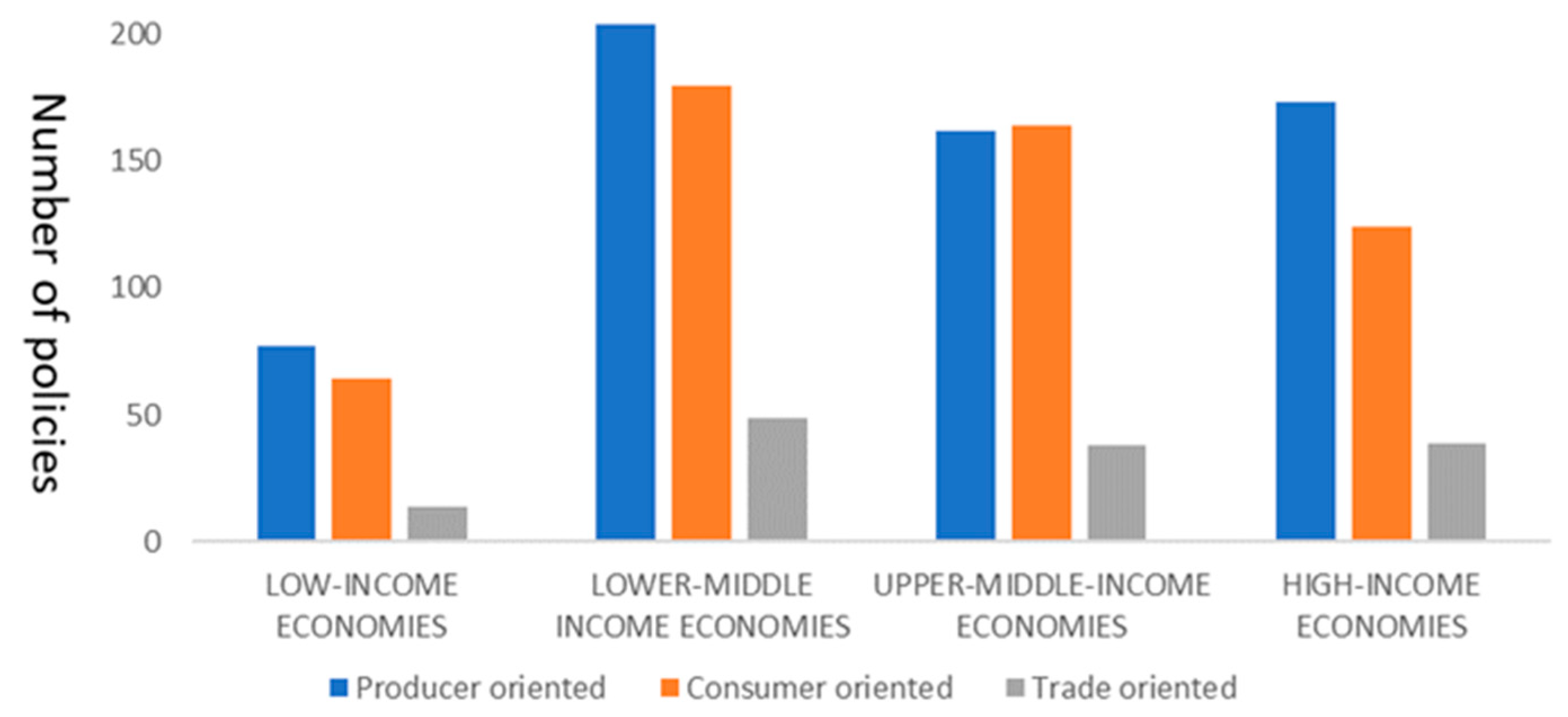
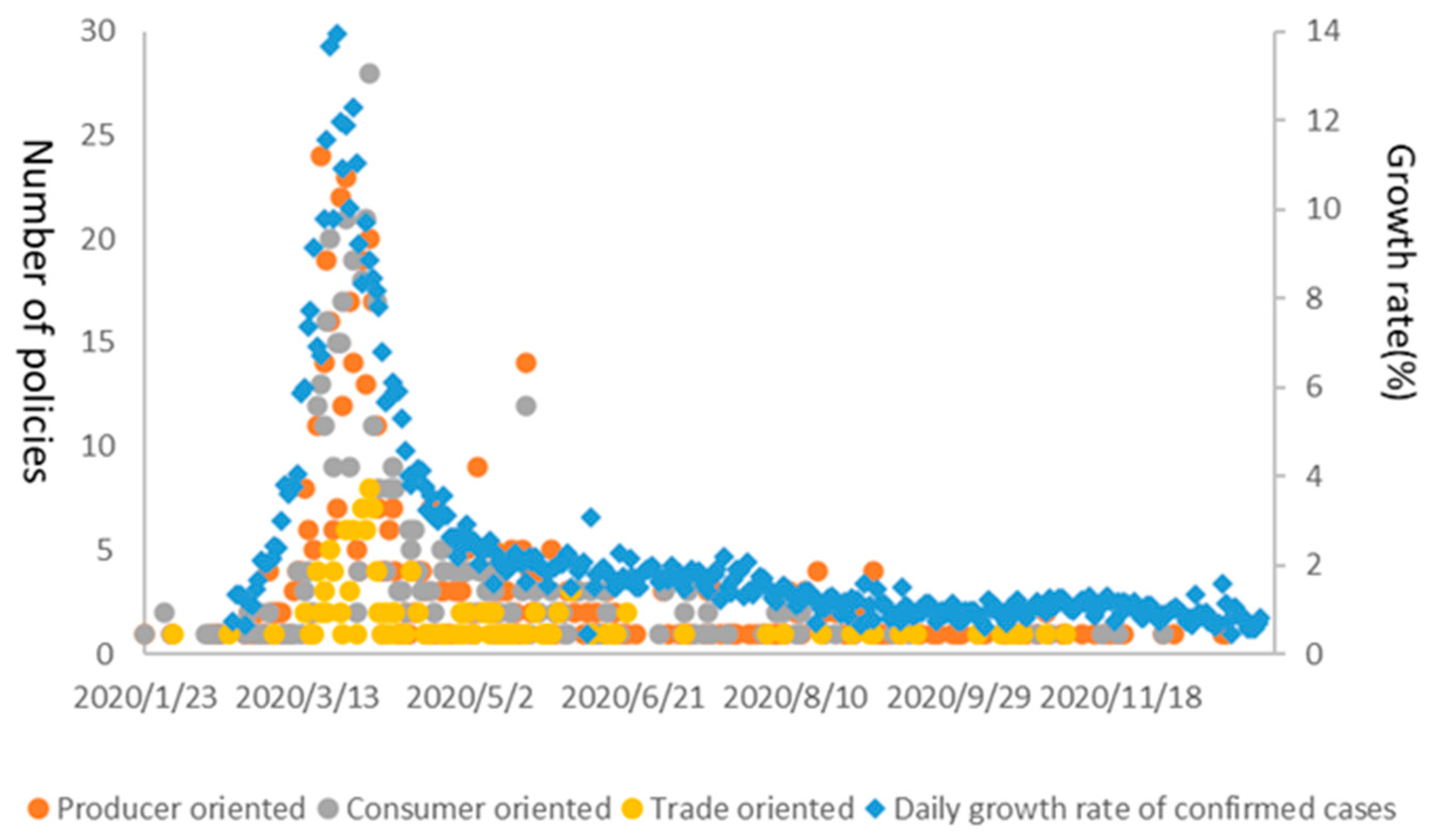
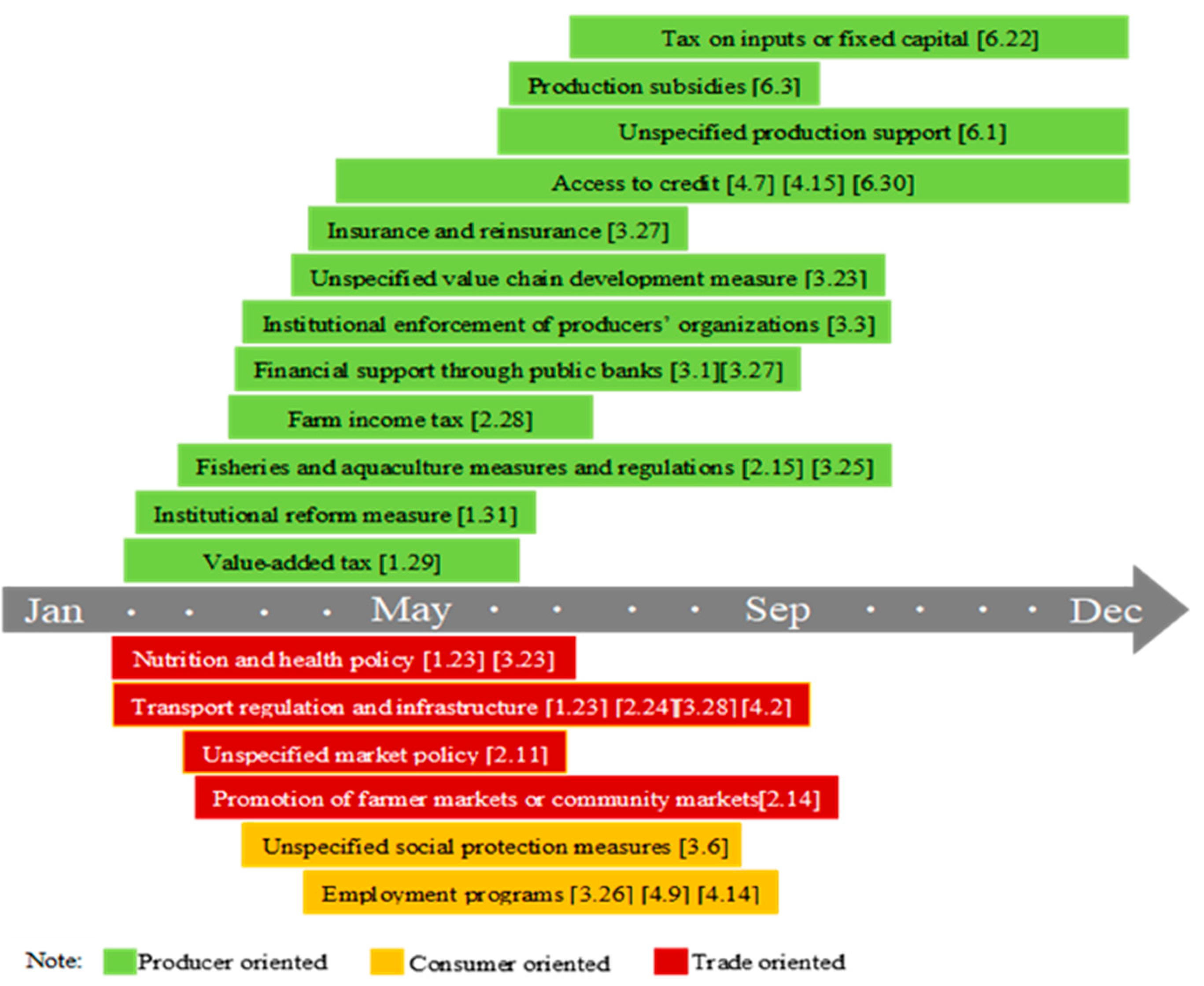


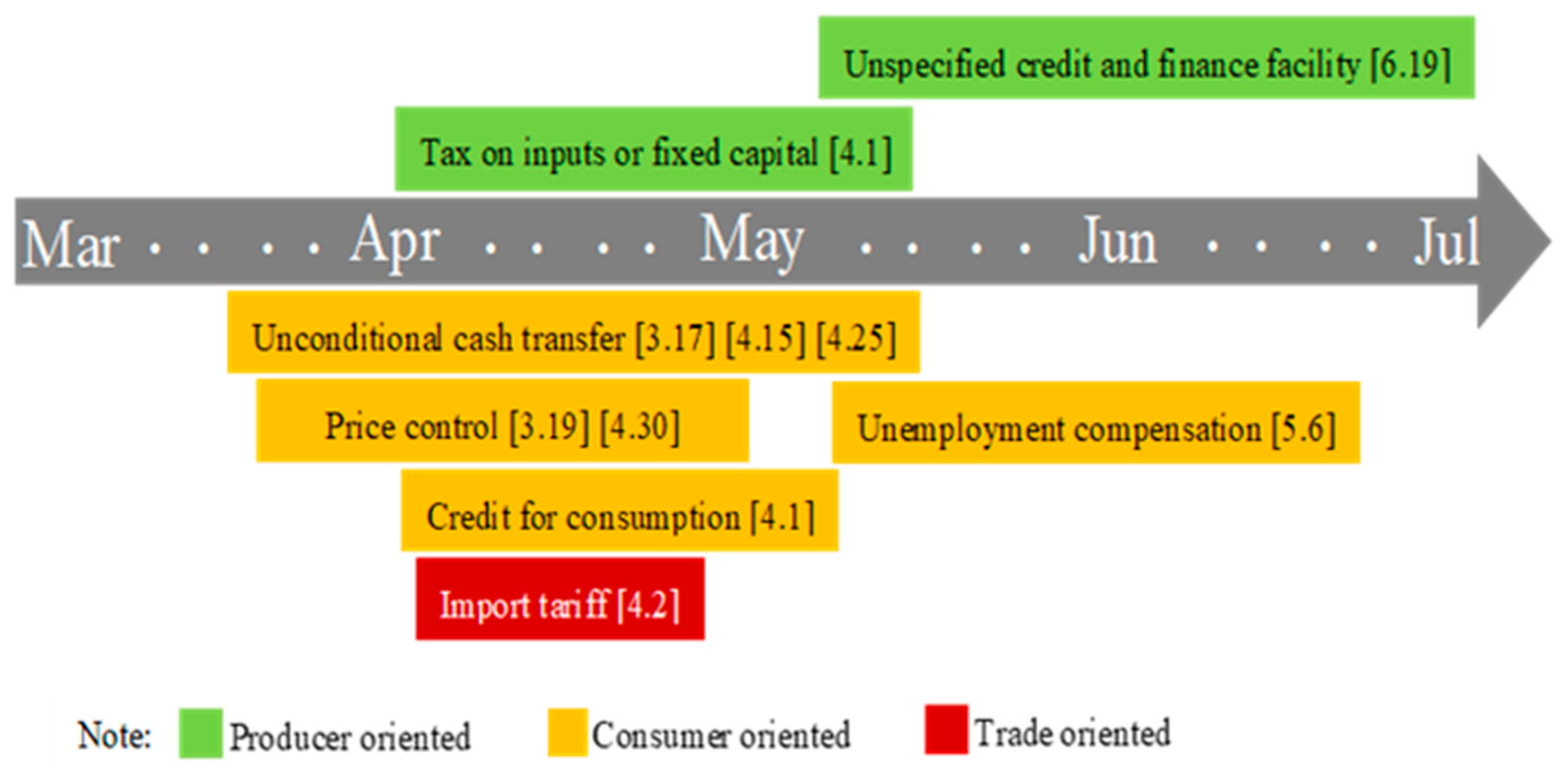
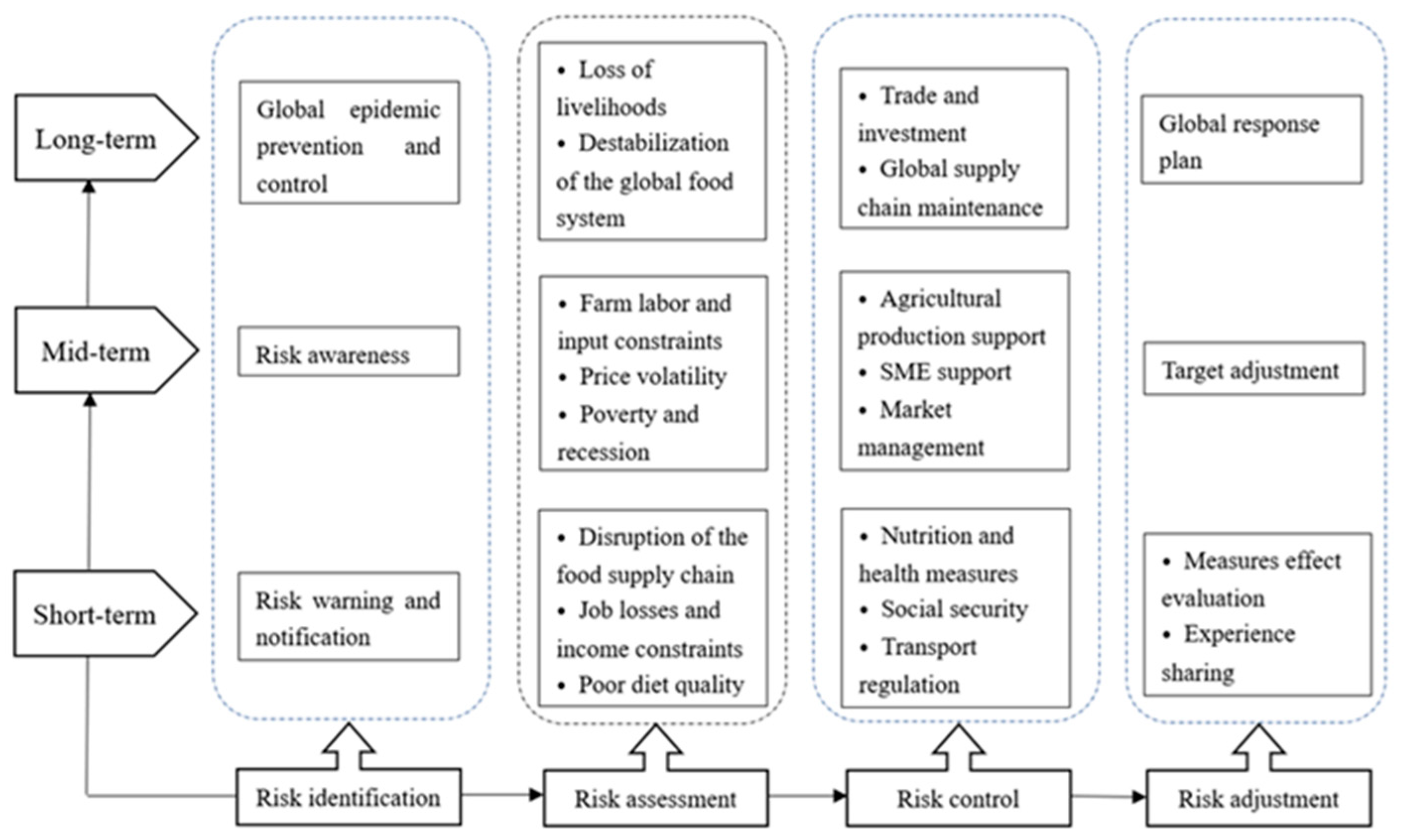
| Indicators | China | Italy | Malawi | Argentina |
|---|---|---|---|---|
| GDP per capita (current US dollars) | 10,261.68 | 33,189.57 | 411.55 | 10,006.15 |
| Cultivated land (hectare per capita) | 0.09 | 0.11 | 0.22 | 0.90 |
| Grain production (metric tons per capita) | 0.44 | 0.27 | 0.20 | 1.70 |
| Cereal imports/Cereal production (%) | 4.38 | 86.49 | 5.05 | 0.02 |
| Cereal exports/Cereal production (%) | 0.44 | 8.63 | 0.08 | 55.19 |
| Consumer Oriented | Producer Oriented | Trade Oriented | |
|---|---|---|---|
| Africa | In-kind food transfer (10), Nutrition and health policy (9), Subsidies on fuel, power and water (8), Unspecified social protection measures (7), Unconditional cash transfer (7) | Institutional measure (17), Transport regulation and infrastructure (13), Public/mutual fund and contingent risk financing (11), Public institution (8), Access to credit (7) | Macroeconomic policy (8), Agricultural expenditure in the national budget (3), Other trade and trade-related measures (2), Export tax (1), Import tariff (1) |
| North America | Unconditional cash transfer (1), Production subsidies (1) | Financial support through public banks (2), Production subsidies (1), Support to productive assets (1), Risk management measures (1) | |
| Asia and the Pacific | Conditional cash transfer (13), Sanitation and hygiene (9), Transport regulation and infrastructure (8), Unspecified production support (8), Unconditional cash transfer (7) | Transport regulation and infrastructure (18), Financial support through public banks (12), Unspecified production support (12), Access to credit (9), Institutional measure (8), Government procurement through imports (8) | Macroeconomic policy (9), Agricultural expenditure in the national budget (7), Transport regulation and infrastructure (5), Export ban (5), Trade facilitation (4) |
| Europe | Unemployment compensation (6), Financial support through public banks (6), Unconditional cash transfer (6), Employment programs (6), Access to credit (6) | Financial support through public banks (13), Access to credit (11), Public/mutual fund and contingent risk financing (9), Production subsidies (7), Institutional measure (7) | Agricultural expenditure in the national budget (6), Export quota (2), Import ban (2), Import tariff (2), Macroeconomic policy (2) |
| Latin America and the Caribbean | Unconditional cash transfer (10), In-kind food transfer (6), Credit for consumption (5), Price control (5), School feeding (5) | Promotion of farmer markets or community markets (7), Transport regulation and infrastructure (6), Access to credit (4), Unspecified credit and finance facility (4), Financial support through public banks (4) | Macroeconomic policy (4), Export ban (1), Import quota (1), Import tariff (1), Other measures that affect imports (1) |
| Near East | Conditional cash transfer (7), Price control (6), Unconditional cash transfer (6), In-kind food transfer (5), Unemployment compensation (4) | Institutional measures (9), Transport regulation and infrastructure (8), Financial support through public banks (6), Access to credit (5), Public institution (5) | Export ban (4), Import tariff (3), Macroeconomic policy (3), Government procurement through imports (2), Trade facilitation (2) |
| Round | 1 | 2 | 3 | 4 | 5 | 6 | 7 | 8 | 9 | 10 | 11 |
|---|---|---|---|---|---|---|---|---|---|---|---|
| Food | 67.1 | 63.5 | 63.7 | - | 65.5 | 62.9 | 62.8 | 62.7 | 54.9 | - | 40.0 |
| Income | 89.8 | 89.2 | 86.6 | 75.9 | 74.5 | 70.1 | 86.7 | 80.0 | 70.6 | - | 66.1 |
Publisher’s Note: MDPI stays neutral with regard to jurisdictional claims in published maps and institutional affiliations. |
© 2021 by the authors. Licensee MDPI, Basel, Switzerland. This article is an open access article distributed under the terms and conditions of the Creative Commons Attribution (CC BY) license (https://creativecommons.org/licenses/by/4.0/).
Share and Cite
Jiang, X.; Chen, Y.; Wang, J. Global Food Security under COVID-19: Comparison and Enlightenment of Policy Responses in Different Countries. Foods 2021, 10, 2850. https://doi.org/10.3390/foods10112850
Jiang X, Chen Y, Wang J. Global Food Security under COVID-19: Comparison and Enlightenment of Policy Responses in Different Countries. Foods. 2021; 10(11):2850. https://doi.org/10.3390/foods10112850
Chicago/Turabian StyleJiang, Xiaoyu, Yangfen Chen, and Jieyong Wang. 2021. "Global Food Security under COVID-19: Comparison and Enlightenment of Policy Responses in Different Countries" Foods 10, no. 11: 2850. https://doi.org/10.3390/foods10112850
APA StyleJiang, X., Chen, Y., & Wang, J. (2021). Global Food Security under COVID-19: Comparison and Enlightenment of Policy Responses in Different Countries. Foods, 10(11), 2850. https://doi.org/10.3390/foods10112850







